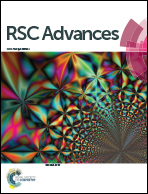Quantitative determination of leukocyte esterase with a paper-based device†
Abstract
The commercially-available colorimetric urine dipstic for the early detection of urinary tract infection (UTI) has several limitations. The quantitative determination of urinary leukocyte esterase (LE) for predicting UTI remains uncertain. This study presents a paper-based analytical device to detect LE (LE-PAD) as a point-of-care quantitative test for UTI. The LE-PAD is composed of a coating of mixed 3-(N-tosyl-L-alaninyloxy)-5-phenylpyrrole (PE) and 1-diazo-2-naphthol-4-sulfonic acid (DAS) deposited onto a silver conducting film (Ag film). The LE/urine reacts with the PE and DAS, and the resulting products in turn react with the silver coating, causing a change in resistivity. The quantitative calibration curve was established in this study and has been used to analyse urine samples from inpatients with urinary catheters (n = 21). The results revealed that the level of LE determined by LE-PADs was predictive of UTI diagnosis with an area under the receiver operating characteristic curve of 0.875 (95% confidence interval, 0.704–1.000). Using an appropriate cut-off value, the sensitivity and specificity of UTI diagnosis by LE-PAD were 87.5% and 92.3%, while the LE-positivities of urine dipstics were 62.5% and 76.9%, respectively. For UTI diagnosis, the LE-PAD demonstrated positive and negative likelihood ratios of 11.38 and 0.14, suggesting that the novel LE-PAD is a reliable test.



 Please wait while we load your content...
Please wait while we load your content...